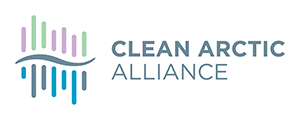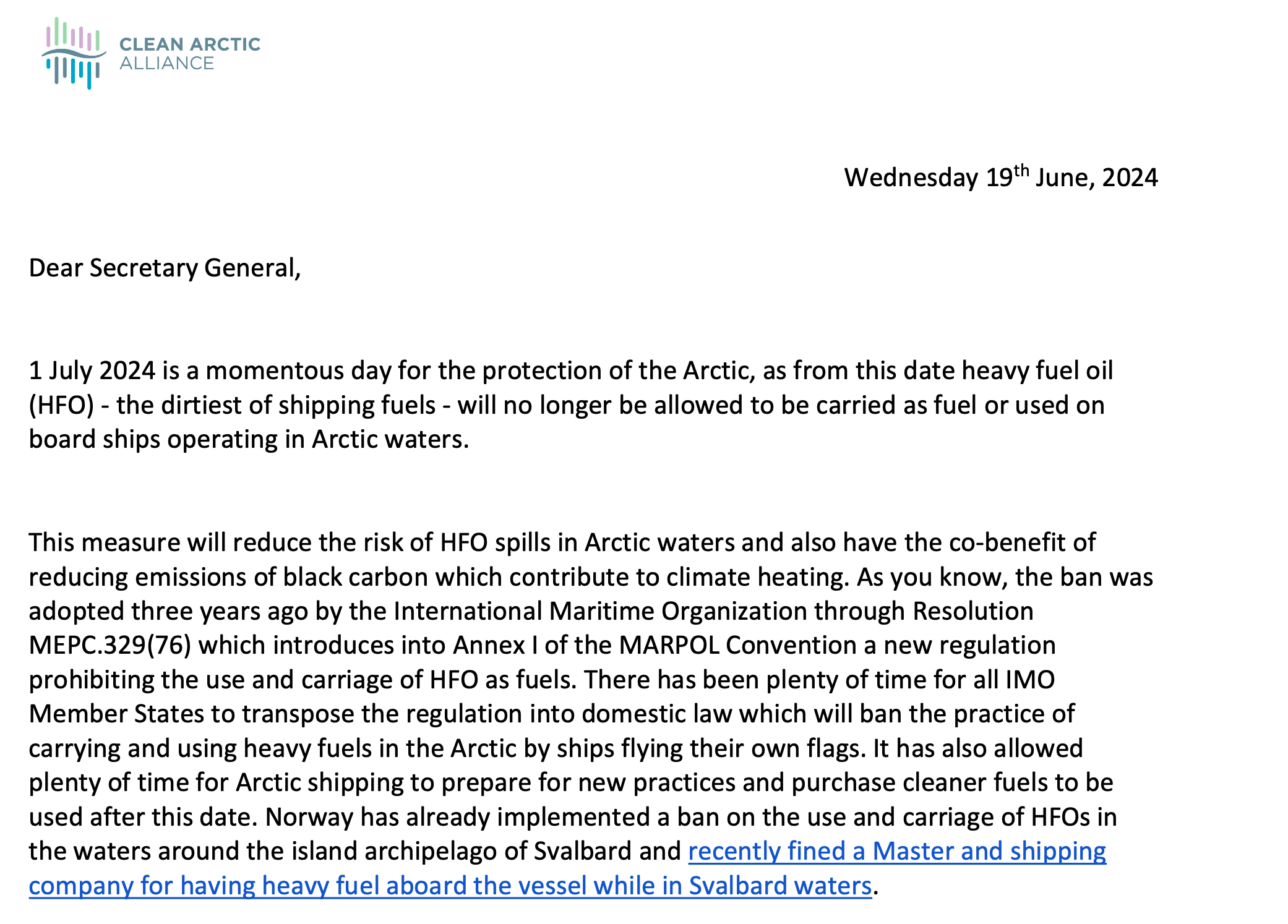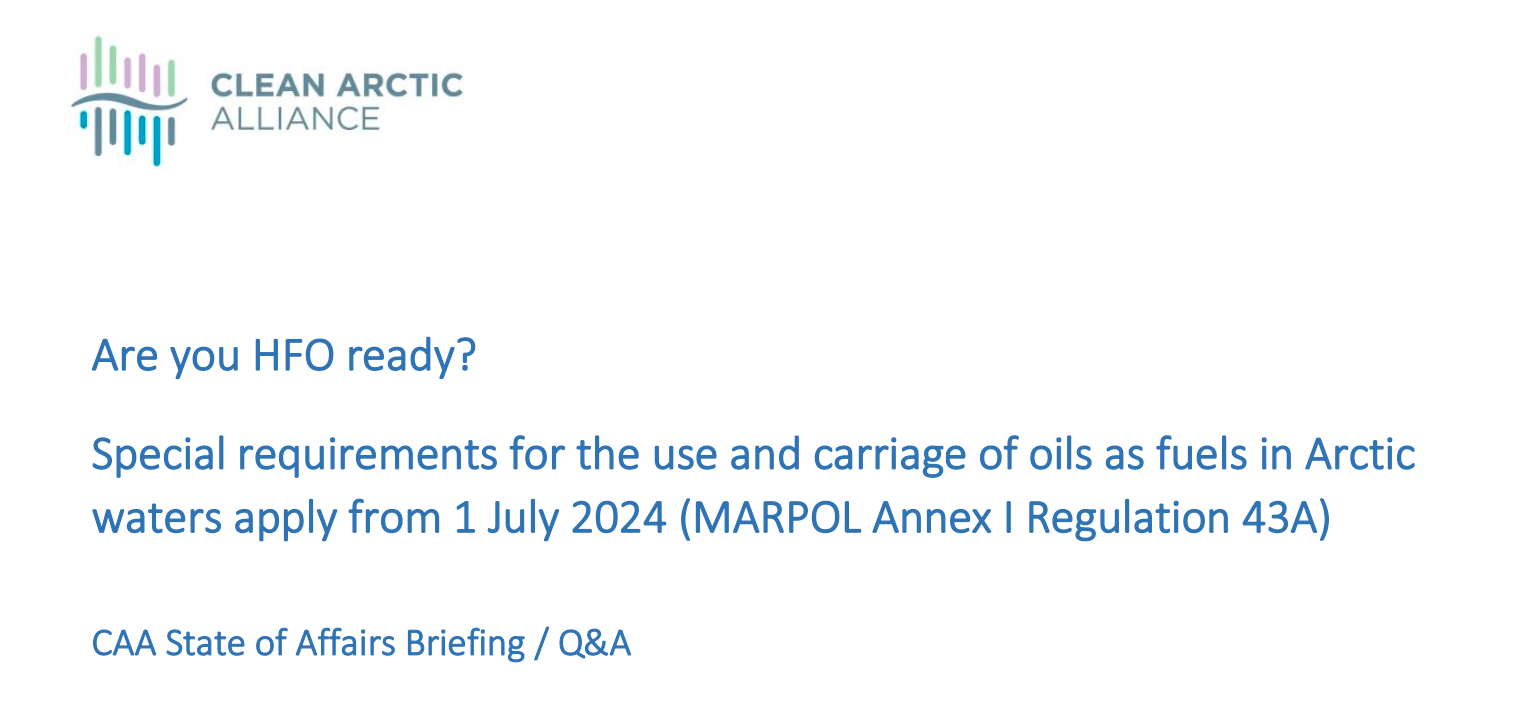Visit our main Heavy Fuel Oil page
What is heavy fuel oil (HFO)?
Heavy fuel oil or HFO is defined in MARPOL Annex I Regulation 43.1. The definition of HFO used for the Arctic ban includes all oils, other than crude oils, with a density at 15oC higher than 900 kg/m3 or a kinematic viscosity at 50oC higher than 180 mm2/s. This includes what are generally known as residual oils – the oil that is left after the refining process which have been used as the primary fuel for international shipping for a considerable time. Today, these heavy fuel oils which have a high sulphur content can only be used in combination with a scrubber to remove the sulphur in the exhaust. In response to the restrictions on the sulphur content of ships’ fuels, the oil industry has created blends of residual fuels and lighter fuels to create very low sulphur fuel oils (ULSFOs) and ultra low sulphur fuel oils (ULSFOs) with a lower sulphur content, however it appears that most of these fuels still qualify as heavy fuels under the MARPOL Annex I Regulation 43.1.
Will HFO use and carriage be completely banned in the Arctic after 1 July 2024?
No. Regulation 43A of MARPOL Annex I will allow a significant number of ships to continue burning HFO until 1 July 2029 through two separate mechanisms. First, Regulation 43A of MARPOL Annex I includes an exemption for ships that comply with specific fuel tank design requirements set forth in Regulation 12A of MARPOL Annex I and Regulation 1.2.1 of Chapter 1 of Part II-A of the Polar Code. These fuel tank design provisions essentially require that the fuel tank be separated from the outer shell of the ship by a particular distance. Second, Regulation 43A of MARPOL Annex I will allow Arctic coastal nations to issue waivers for ships flying the flag of that nation while operating in waters subject to the sovereignty or jurisdiction of that nation. For example, Canada could grant a waiver for a Canadian flagged vessel to continue using HFO in “Canadian waters.”
In a study based on 2019 Arctic shipping data, the International Council on Clean Transportation determined that 22 percent of the Arctic fleet (in 2019) would be exempt from Regulation 34A of MARPOL Annex I as a result of the fuel tank design exemption and a further 53 percent would be eligible for a waiver. Together, nearly three-quarters (74%) of the HFO-fuelled fleet in 2019 would be able to continue to use HFO until 1 July 2029. The study ultimately demonstrated that only 30 percent of the HFO being carried in Arctic waters and 16 percent of the HFO being used in Arctic waters would be prohibited in 2024.
What was the purpose of Regulation 43A of MARPOL Annex I?
The stated purpose of MEPC’s work programme relating to the “HFO ban” was to develop “measures to reduce environmental risks of use and carriage of HFO as fuel by ships in Arctic waters, particularly with respect to environmental damage associated with potential spills of that fuel.” While black carbon emissions were part of early discussions related to the “HFO ban,” the output ultimately focused solely on addressing the spill risk.
The final text of Regulation 43A of MARPOL Annex I reflects this singular focus, as the exemption for ships that comply with specific fuel tank design requirements, and the allowance for Arctic coastal nations to issue waivers will allow ships to continue burning HFO and emitting high levels of black carbon emissions until 1 July 2029. This is why the Clean Arctic Alliance continues to urge the IMO, through another workstream, to immediately adopt a mandatory switch to distillate fuels for ships operating in and near the Arctic.
III. How does Regulation 43A of MARPOL Annex I compare to the Antarctic HFO ban?
MARPOL, Annex I, Regulation 43, which applies in Antarctica, took effect on August 1, 2011 and prohibits ships travelling in the Antarctic area (south of 60oS) from carrying and using HFO as fuel, carrying HFO as ballast, as well as carrying HFO as cargo. The Antarctic HFO ban does not include any exemptions or waivers except for a standard exemption for vessels engaged in securing the safety of ships or in a search-and-rescue operation.
Do the fuel tank design requirements in Regulation 12A of MARPOL Annex I and Regulation 1.2.1 of Chapter 1 of part II-A of the Polar Code actually reduce the risk of an oil spill?
Often touted as the most effective technology available to prevent oil spills from ships, protected fuel tanks are most effective in low energy collisions that are likely to occur in areas where vessels are travelling at slower speeds, such as ports and restricted waterways. However, protected fuel tanks are less effective in higher speed collisions, groundings on hard substrates or rocks, or collisions with sharp objects (e.g. icebergs, and chunks of ice in the water). There are a number of examples of oil spills from ships with protected fuel tanks. For example, in 2018, Sanchi, a double-hull, ultra-light crude oil tanker collided with another cargo ship 160 nautical miles off the coast of Shanghai, China. Sanchi caught fire shortly after the collision, burned and drifted for over a week, and then finally sank. Sanchi was carrying 136,000 tonnes of crude oil.
Overall, while protected fuel tanks may reduce the risk of an oil spill in certain circumstances, they cannot prevent all oil spills because they do not reduce the likelihood of a vessel accident (collision or grounding and consequent breach of the fuel tanks).
Does Regulation 43A of MARPOL Annex I apply to the entire Arctic?
No. The Arctic is defined differently by various domestic and international organisations as well as legal agreements. The IMO’s definition of “Arctic waters,” which is the definition that applies to Regulation 43A of MARPOL Annex I, was developed to improve the safety of ships operating in ice-covered waters which led to the adoption of a Polar Code. It encompasses waters in the Arctic that pose the greatest safety risk to ships operating in the Arctic region.
Specifically, the IMO defines Arctic waters as “those waters which are located north of a line extending from latitude 58°00’.0 N, longitude 042°00’.0 W to latitude 64°37’.0 N, longitude 035°27’.0 W and thence by a rhumb line to latitude 67°03’.9 N, longitude 026°33’.4 W and thence by a rhumb line to Sørkapp, Jan Mayen and by the southern shore of Jan Mayen to the Island of Bjørnøya and thence by a great circle line from the Island of Bjørnøya to Cap Kanin Nos and thence by the northern shore of the Asian continent eastward to the Bering Strait and thence from the Bering Strait westward to latitude 60° N as far as Il’pyrskiy and following the 60th North parallel eastward as far as and including Etolin Strait and thence by the northern shore of the North American continent as far south as latitude 60° N and thence eastward along parallel of latitude 60° N, to longitude 56°37’.1 W and thence to the latitude 58°00’.0 N, longitude 042°00’.0 W.”
However, it is important to note that there are other more expansive definitions of the Arctic. These definitions encompass a much larger area, and provide protection for the whole Arctic region. For example, the Arctic Monitoring and Assessment Program (AMAP) established a definition of the Arctic that incorporates numerous considerations including the Arctic Circle, vegetation boundaries, permafrost limits, and major oceanographic features. With these criteria in mind, the Arctic region covered by AMAP includes terrestrial and marine areas north of the Arctic Circle (66°32’N), and north of 62°N in Asia and 60°N in North America, modified to include the marine areas north of the Aleutian chain, Hudson Bay, and parts of the North Atlantic Ocean including the Labrador Sea. This definition of the Arctic should be considered for future IMO regulations relating to climate emissions, air pollution and environmental protection in the Arctic region.
How will the ban on the use and carriage of HFO in Arctic waters be enforced?
Like all maritime laws, Regulation 43A of MARPOL Annex I can be enforced by either flag-state or port-state control. Under flag-state control, a country has the power and obligation to ensure that ships flying its flag follow all international environmental and safety regulations. Under flag state control for example, the Marshall Islands, a major shipping nation, should enforce the ban on the use and carriage of HFO for any of its flagged ships that operate in Arctic waters. However, it is more likely that Regulation 43A of MARPOL Annex I will be enforced through port state control. Under port state control, a country can inspect a ship docked in its port to verify that the condition of the ship and its equipment comply with the requirements of international regulations (under the Safety of Life at Sea Convention and the MARPOL Convention amongst others) and that the ship is manned and operated in compliance with these rules. For example, if a ship flagged in the Bahamas pulls into Utqiaġvik harbour in northern Alaska carrying HFO, the United States acting under its powers of port state control could impose a penalty for violating MARPOL, Annex I, Regulation 43A. Equally, compliance with Regulation 43A should also be checked for a ship inspected outside of Arctic waters but known to be heading to the Arctic waters, or on its return. The need for ships operating in Arctic waters to hold a Polar Ship Certificate and the Bunker Fuel Delivery Note are likely to be useful for port states to understand where a ship is operating and what fuels it is carrying.
The imposition of any penalties for violating MARPOL, Annex I, Regulation 43A will largely be left to port states to implement.
VII. Have all Arctic nations adopted Regulation 43A of MARPOL Annex I?
No. Based on best available information, it is the CAA’s understanding that three Arctic countries – Russia, Canada, and Finland – have not yet implemented Regulation 43A of MARPOL Annex I into domestic regulation.
Canada plans to introduce the ban on the use and carriage of HFO in Arctic Waters into legislation in December 2024. However, Canadian authorities have indicated that they will implement the ban on 1 July 2024 through a Ministerial order and will grant waivers to community resupply vessels through to July 1 2026.
Finland has also not yet implemented the ban in law, but plans are in place for the ban to be adopted into domestic regulation from 1 January 2025. As Finland is not an Arctic coastal nation, so this delay only has consequences for Finnish flagged vessels operating in the Arctic (of which there were 2 according to the latest data from the Arctic Council’s PAME WG).
The CAA does not have any specific information on Russia’s plans to adopt the Regulation 43A of MARPOL Annex I, however Russia has notified the IMO that the amendments to MARPOL Annex I introducing the Arctic HFO ban will not enter into force for the Russian Federation on 1st November 2022 (the deadline for adopting the regulation).
With respect to other Arctic countries – none have notified the IMO of delayed action or a lack of action with respect to introducing Regulation 43A into domestic regulation. Norway has already banned the use and carriage of HFO throughout the waters of the Svalbard archipelago (the only Norwegian waters within the defined area) since 2022, and is unlikely to issue waivers.
It is expected that Denmark will not issue waivers for ships operating in Greenland’s waters since the ships using HFO will qualify for exemptions until July 2029 as they have protected fuel tanks.
It is believed that the United States has implemented the ban into domestic regulation for US-flagged vessels and is unlikely to issue waivers. It is likely that a considerable number of the US-flagged vessels will also qualify for exemptions until 2029.
Iceland, Sweden and Finland’s waters do not fall within the area to which Regulation 43A applies.
VIII. Will Regulation 43A of MARPOL Annex I reduce black carbon emissions in the Arctic?
No. Regulation 43A of MARPOL Annex I will not significantly reduce levels of black carbon emissions in the Arctic until 1 July 2029. This is because a significant number of ships will be able to continue burning heavy fuel oil until 1 July 2029. Specifically, a study by the International Council on Clean Transportation determined that 22 percent of the Arctic fleet will be exempt as a result of the fuel tank design exemption and a further 53 percent will be eligible for a waiver. Together, nearly three-quarters of the HFO-fuelled fleet in 2019 would be able to continue to use HFO until 1 July 2029. This same study also demonstrated that only 30 percent of the HFO being carried in Arctic waters and 16 percent of the HFO being used in Arctic waters would be prohibited in 2024. For this reason, the International Council on Clean Transportation also concluded that the Regulation 43A of MARPOL Annex I is only expected to reduce BC emissions by 5% from business as usual emissions until exemptions for ships with protected fuel tanks and waivers for ships flagged to Arctic coastal states expire in 2029.
Furthermore, shipping in the Arctic is increasing and between 2015 and 2021 black carbon emissions have more than doubled as a consequence. This increase in shipping is expected to continue and as a result, it is anticipated that the small decrease resulting from the HFO ban in 2024 will be outpaced very quickly by the increase in emissions as shipping in the region grows.
In addition, Regulation 43A of MARPOL Annex I only applies to ships operating in Arctic waters. Ships operating just outside of “Arctic Waters” will never be subject to a ban on the use of HFO under Regulation 43A of MARPOL Annex I. Due to the transboundary nature of air emissions, black carbon emissions from ships operating outside of the IMO definition of “Arctic Waters” will be carried into the Arctic.
This is why the CAA continues to advocate for a mandatory shift to distillate fuels for ships operating in and near the Arctic.
What are the benefits of distillate fuels compared to HFO?
Using distillate fuels as opposed to HFO is better from both a spill and an emissions perspective.
Although a spill of any type of oil can cause irreversible damage to the environment, the ultimate consequences and hazards of an oil spill largely depend on the properties of the specific oil. For example, distillate fuels, such as marine gas oil (MGO), tend to evaporate and dissolve faster than HFO and, although toxic, they do not emulsify on the ocean surface. Conversely, HFO demonstrates a strong tendency to solidify rapidly and form tar lumps in marine waters. This not only results in a significant increase in the volume of waste to be handled in the event of a spill, but also makes HFO more persistent in the environment. In addition, most liquid hydrocarbons, such as distillate fuel, tend to spread into a slick over the water surface, which allows oil recovery teams to detect and track a spill through aerial observations. On the other hand, due to a deficiency of “lighter” compounds in HFO, there may be no sea surface sheen to aid in the aerial detection of an HFO spill. Furthermore, HFO is not typically as buoyant as distillate fuel and may not float on the sea surface. The long-term consequences of sunken oil are highly complex, but can include the incorporation of oil in ocean and coastal sediments.
Burning distillate fuel instead of HFO also results in significant reductions in black carbon emissions. Fuel emission factors used in The Fourth IMO GHG Study show that, when used in the same engine, a switch to distillate reduces black carbon emissions per kilogram of fuel consumption by up to 79% in 2-stroke engines and by up to 48% in four-stroke engines. Installing a diesel particulate filter on ships burning distillate fuel would further reduce black carbon emissions by over 90%.
How do Indigenous communities feel about the HFO ban?
The Inuit Circumpolar Council (ICC) supported a stronger and more comprehensive HFO ban at the IMO because many Indigenous Peoples in the Arctic depend on ocean resources for food security. A large proportion of their daily diet comes from the sea, so disruptions and threats to those resources have an impact on livelihoods and the well being of communities in the region. Indigenous communities are also concerned about increased costs of shipping essential commodities to remote communities in the Arctic. So, alongside the ban, Inuit have been calling for cost mitigation measures to be put in place to ensure communities aren’t burdened by any increased costs associated with the move to cleaner, more expensive fuels.
Inuit Circumpolar Council (ICC) stated in a November 24, 2020 press release:
‘The current HFO regulation as passed will not effectively protect the Arctic from HFO for over a decade, yet it is labelled a ban. The regulation as written sets up an inconsistent approach to environmental protection between territorial and international waters and increases the possibility of transboundary pollution. Protections that take effect in ten years do nothing to address the immediate impacts and imminent threat of a HFO spill and climate change. Inuit Circumpolar Council is of the opinion that the most effective near-term solution for climate change is to greatly reduce the emission of black carbon, produced from HFO, in the region. An appropriate HFO ban would have recognized this as well as implemented further protections against an oil spill and the devastating effects on the Arctic marine environment.’




